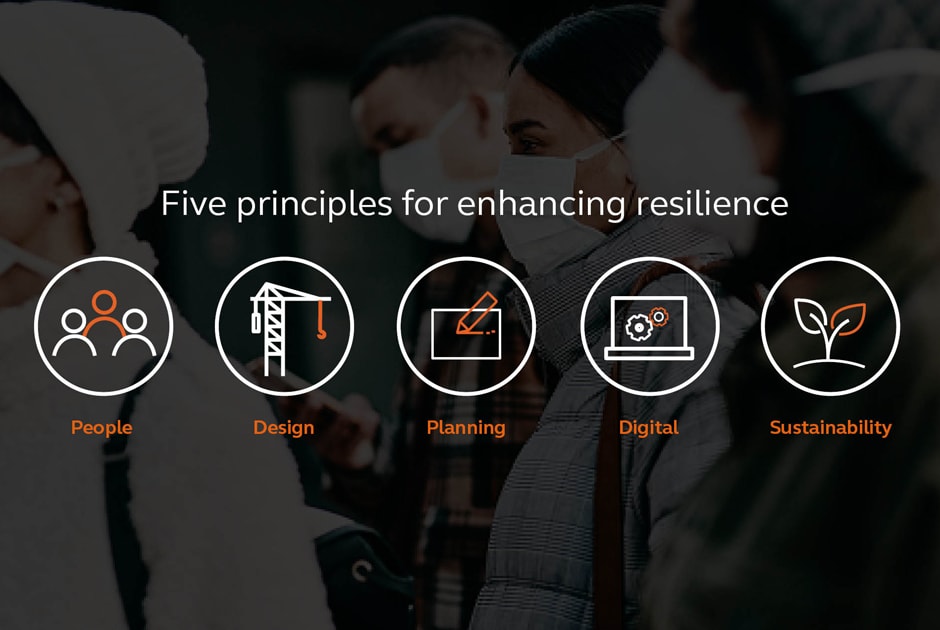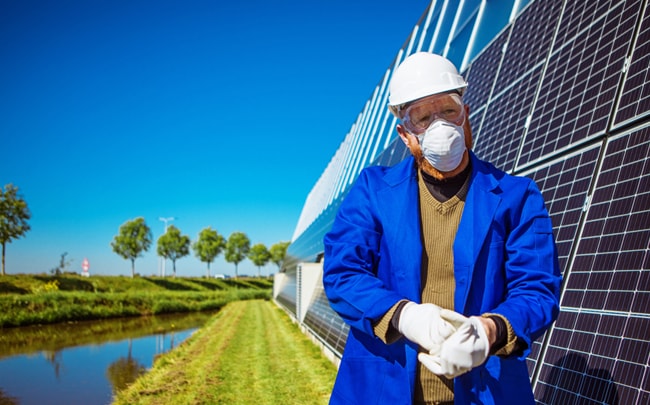- Resilience
- Business continuity
- Utility resilience
- Covid-19
- Cities
- Safety
What should your company do to get better prepared for future events that could cripple operations?
In the aftermath of shutdowns caused by the COVID-19 pandemic, many decision makers at some of the world’s leading companies have approached me with essentially the same question:
What steps should I be taking to help ensure that my company can avoid costly disruptions to business in the future?
While each company and each industry is unique and no “one size fits all” approach will suffice, broadly speaking there are five specific areas that should be the focal points for action to make any company more resilient against COVID-19, other pandemics or whatever else the future holds.

People, design, planning, digital and sustainability are the five principles we focus on in order to help our clients bounce back stronger from COVID-19 and position themselves to avoid costly shutdowns in the future.

People
Societies, cities, communities, and organizations are only as resilient as their people. After the pandemic, we must focus on improving the health and wellbeing of the most vulnerable, and enhance the resilience of wherever they live, work or play. One example of this is promoting and incentivizing healthy lifestyles in order to cultivate a more resilient workforce. We have seen during the pandemic that people who already suffered from health problems have been hardest hit by COVID-19. So, improving the overall health of your workforce, for instance by providing free, healthful foods in the office or subsidizing gym memberships, will make your company better prepared to continue operating during a future pandemic.

Design
Resilience can be enhanced by embracing new ways of designing and retrofitting buildings, facilities, and urban spaces in a post-pandemic world. No matter what type of business you run or work at, there’s a good chance that the building space you use (whether office space, manufacturing facilities or R&D labs) have had to undergo extensive changes to accommodate new safety and hygiene standards, aimed at curtailing the spread of the coronavirus. This has highlighted the fact that buildings that were designed to be easily adaptable can provide many advantages to a business. They contribute to making operations more resilient.

Planning
Resilience thinking must be placed at the heart of business continuity planning. Collaboration must also be embraced, between communities, organizations, industry sectors and supply chains. Many companies out there had to shut down, not because their workforces had become infected with COVID-19 nor because the virus was widespread within the communities within which they operated. No, in fact, those companies had to discontinue operations because outbreaks in other parts of the world cut off their sources of critical supplies. As these, and all other companies, recovery from the pandemic, they should develop more comprehensive and inclusive stakeholder engagement plans that extend through multiple tiers of their supply chains. Companies should conduct a global supply chain analysis, which includes supplier evaluations and site assessments, in order to develop a proper assessment of the risks. This should also include a masterplan assessment of production sites, as well as a determination of the potential costs and benefits of both reshoring and adopting multi-siting approaches. This will generate a clearer understanding of vulnerabilities and point to steps companies can take to ensure constant access to critical supplies, no matter what happens.

Digital
Digital tools and platforms are essential for gathering and analyzing data, which can inform smart decisions that can ensure business continuity and lead to competitive advantage. Perhaps more than anything, the pandemic has vividly demonstrated the utility of digital ways of working. Going forward, where possible, all organizations should accelerate the adoption of digital tools to manage facilities, assets, health and safety and supply chains. Additionally, the use of digital platforms helps generate data and insights that can be leveraged for competitive advantage.

Sustainability
Resilience and sustainability go hand-in-hand. By implementing projects that improve sustainability performance, reducing resource consumption and protecting the environment, organizations enhance long-term resilience. For instance, an expedited, global transition to clean, renewable energy is a laudable sustainability goal, but COVID-19 has shown us that this would also make people, organizations, and society more resilient to pandemics. Air pollution from fossil fuels kills roughly seven million people each year and damages the airways of countless others. This creates so-called underlying conditions that exacerbate the negative consequences of contracting the coronavirus or other communicable diseases. So, reducing global air pollution by switching to more sustainable sources of energy will enhance resilience and also will help reduce our collective carbon footprint.
These are just a handful of examples of how a focus on these five means of enhancing resilience can help organizations do a better job of coping with pandemics or whatever else the future may hold. Arcadis experts have developed much more advice along these lines and it is available to you in a series of white papers we have produced as part of our Post-pandemic Resilience campaign. I hope you will take the time to explore these recommendations and learn about concrete steps you and your business can take to get better prepared for the future.





